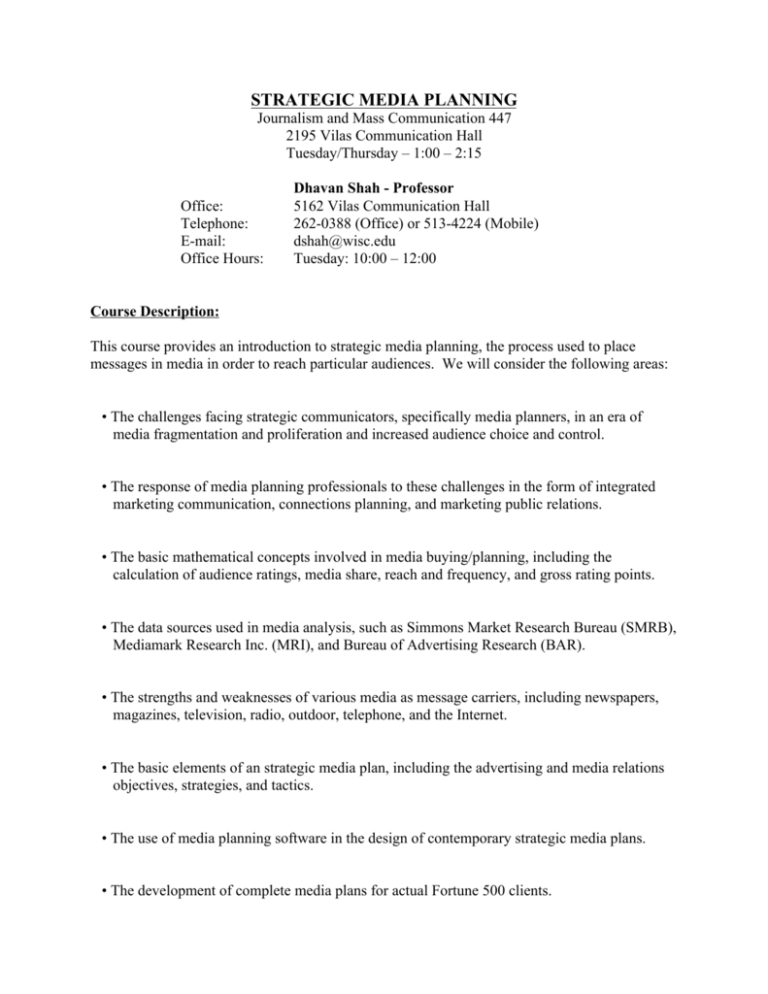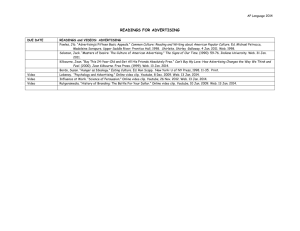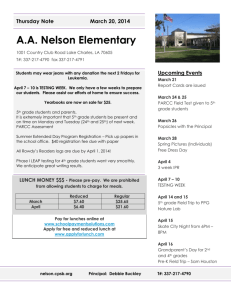strategic media planning - School of Journalism and Mass
advertisement

STRATEGIC MEDIA PLANNING Journalism and Mass Communication 447 2195 Vilas Communication Hall Tuesday/Thursday – 1:00 – 2:15 Office: Telephone: E-mail: Office Hours: Dhavan Shah - Professor 5162 Vilas Communication Hall 262-0388 (Office) or 513-4224 (Mobile) dshah@wisc.edu Tuesday: 10:00 – 12:00 Course Description: This course provides an introduction to strategic media planning, the process used to place messages in media in order to reach particular audiences. We will consider the following areas: • The challenges facing strategic communicators, specifically media planners, in an era of media fragmentation and proliferation and increased audience choice and control. • The response of media planning professionals to these challenges in the form of integrated marketing communication, connections planning, and marketing public relations. • The basic mathematical concepts involved in media buying/planning, including the calculation of audience ratings, media share, reach and frequency, and gross rating points. • The data sources used in media analysis, such as Simmons Market Research Bureau (SMRB), Mediamark Research Inc. (MRI), and Bureau of Advertising Research (BAR). • The strengths and weaknesses of various media as message carriers, including newspapers, magazines, television, radio, outdoor, telephone, and the Internet. • The basic elements of an strategic media plan, including the advertising and media relations objectives, strategies, and tactics. • The use of media planning software in the design of contemporary strategic media plans. • The development of complete media plans for actual Fortune 500 clients. Course Objective: This course is designed as a concepts/skills course; it will emphasize critical thinking regarding media planning for advertising, public relations, and health and political communication campaigns. To achieve these objectives, we will use a combination of lectures, lab sessions, readings, discussions, assignments, and computer simulations. Participation is the key to success in this course. • For the student who is hoping to pursue Media Planning as a career, this course will serve as an introduction to the process of critically evaluating media options, purchasing or placing strategic communications in media outlets, scheduling media weight in a manner that achieves communication goals, and evaluating the impact of media on audience members. This course will provide a simulation of how a strategic media plan in researched, conceived, and executed. • For the student who is not planning on pursuing Media Planning as a career, this course will serve as a foundation for understanding the role of media in the broader strategic communication landscape. The course will detail how account management, research and account planning, creative, database marketing, sale promotion, and, particularly, public relations relate to media planning. Course Materials: Jack Z. Sissors and Roger Baron (2002). Advertising Media Planning, 6th edition. New York: McGraw-Hill. (5th edition is acceptable if you can find one at a good price). Dennis Martin and Robert Coons (2002). Media Flight Plan IV. Provo, Utah: Deer Creek Publishing. (This is a software program that you must purchase, Mac OS version preferred). Clarke Caywood (ed) (1997). The Handbook of Strategic Public Relations and Integrated Communications, New York: McGraw-Hill. (Readings are on Reserve in JRR) Esther Thorson and Jeri Moore (eds.) (1996) Integrated Communication. Mahwah, NJ: Lawrence Erlbaum (Readings are on Reserve in JRR) Course Policies: • Students must notify the instructor within the first two weeks of class of any specific days that they will miss class for religious observance. • If a student cannot compete an assignment or take an exam at the scheduled time, arrangements must be made in advance with the instructor. Failure to do so will result in the reduction of one grade level (at a minimum) from the earned score. Exemptions may be made for unusual circumstances. • Permission for a student to receive an incomplete grade (I) is at the discretion of the instructor and must be accompanied by a written contract for completion of course requirements. Failure to take exams, complete assignments, or attend class is not acceptable reasons for an incomplete. • This class will follow University and L&S guidelines concerning scholastic misconduct and grievance procedures. • The course syllabus is available in alternative formats upon request. Please see the undergraduate advisor if you need an alternative format due to a disability. Course Grade: The course grade will be based on four components: In-class mid-term exam #1 (25%) Take-home mid-term exam #2 (25%) Final individual project (35%) Class participation (15%) • The midterm exams and final exam will account for 50% of your grade. The first midterm exam will be given during class time and will cover course material presented up to the date of the exam. The second mid-term exam will be a take-home and will cover course material presented after the first mid-term exam, though it will require a basic understanding of concepts you encountered in the first five weeks. Information presented in readings, workbooks, or lecture may appear on the exams. • The final project requires each student to create a media plan for a specified product or service. Each student will be assigned an existing product from a major product category (e.g., BMW automobiles in the luxury car category). Other students in the class will be assigned competing products (e.g., Mercedes Benz or Saab). A total of six or seven product categories will be used, meaning that approximately four or five students will compete against one another in each product category. Each student must engage in primary and secondary research to understand the marketing problem, formulate clear media objectives related to advertising and public relations, and determine core media strategies and tactics. A computer simulation will be used to execute planning decisions and determine costs. Specific processes will be discussed during the course. The project is 35% of your final grade • The remaining 15% of your grade will be based on assignments and participation. A willingness to express opinions, offer examples, or ask question will determine this part of your grade. Absences and tardiness also will be reflected in this grade portion. Basic Procedures for Final Project Develop Situation Analysis Marketing analysis (annual reports, news articles, government resources) Target Audience analysis (Simmons Market Research Bureau, Mediamark Research) Competitive analysis (Bureau of Advertising Research, Leading National Advertisers) Define Media Objectives Target audience – Define primary & secondary audiences Seasonality – selling period and pre-promotion Geography – regionality and DMA concentration Plan Performance - Reach and Frequency - Effective Frequency Goals Scheduling Strategy – Flighting, Pulsing, or Continuity. Determine Media Strategy Media mix and vehicle selection for purchase (media buying) Media vehicles for press placements (public relations) Attainment of performance objectives – Especially Effective Reach CPMs and GRPs by medium for advertising; GRPs by medium for public relations Detail Decisions in Media Flowchart Detail monthly spending and media distribution of paid and unpaid media Assembling the Elements of the Plan 1) Executive summary of the media plan. 2) Marketing objectives and strategies that relate to media. 3) Copy strategy statement -- how media supports copy. 4) Competitive Media Expenditures Analysis 5) Clearly stated media objectives that are tied to marketing strategies and objectives. 6) Clearly stated media strategies tied to the media objectives. 7) Media plan details and documentation. • Criteria for determining media values. • Data showing monthly reach and frequency • Data showing effective reach levels • Detailed account of selected media classes, or subclasses, including CPMs • Yearly flowchart for national and spot You will received a media plan checklist and an the annotated media plan, for additional details and guidance about how to prepare your plans. Internet Resources Advertising World: a site sponsored by the University of Texas-Austin’s advertising department. Simply, the most extensive collection of advertising related links on the web. Special section on media buying and planning and interactive marketing. http://advertising.utexas.edu/world/index.asp American Marketing Association: The AMA is one of the largest professional associations for marketers, with over 38,000 members. This site is an essential resource, providing relevant information. Look under “marketing tools and templates.”. http://www.marketingpower.com/ Newsweek Media Research Index: a site containing a bibliography of over 700 studies, journal articles, conference papers, and books on media research. Substantially cross-referenced. http://www.vmr.com/research/index.html U.S. Census: a site permitting access to Census data on the U.S. population. Alphabetized directory for easy access into a wide-ranging resource. This one is very helpful! http://www.census.gov/ Advertising Age: the website for the leading advertising industry magazine. Critical reading for anyone serious about a career in advertising and marketing. http://www.adage.com/ Brand Week: another website for a leading industry magazine. Tracks brands and branding efforts through a marketing lens. Particularly helpful to aspiring brand managers. http://www.brandweek.com/brandweek/index.jsp Brand Week: another website for a leading industry magazine. Tracks trends in the media marketplace and media vehicles performance. Particularly helpful to aspiring media planners. http://www.mediaweek.com/mw/index.jsp Course Schedule -- Readings, Assignments, and Exams Week 1 9/5 Introduction To Media Planning: Overview of Course 9/7 Era of Choice: Changes in Demographics, Technologies, and Economics Chapter 1 Week 2 9/12 Era of Choice: Media Responses to Diminished Effectiveness Chapter 3 (Chapter 4 in 5th ed.) 9/14 Integrated Marketing Communications and Connections Planning “The Concept, Process, and Evolution of Integrated Marketing Communication,” Thomas Duncun and Clarke Caywood, in Thorson and Moore. “How Leading Advertising Agency Media Directors View Integrated Communication,” Carla Lloyd, in Thorson and Moore Week 3 9/19 Media and Estimates of Audience Size (HUT/PUT, Rating, Share, GRPs) Chapters 4 (Chapter 5 in 5th ed.) 9/21 Media and Estimates of Audience Exposure (Reach, Frequency, CPM/CPP, and VPVH) Chapter 5 (pp. 87 – 105) (Chapter 6 in 5th ed. – pp. 115 – 131) Handout: Worksheet on Media Basics Week 4 9/26 Reach and Frequency: Reach Curves and Effective Frequency Chapter 5 (pp. 106 – 116) (Chapter 6 in 5th ed. – pp. 132 – 148) 9/28 Media Strategy: Understanding Audiences (Simmons/MRI) & Connections Planning Chapter 7 (pp. 159 – 171) (Chapter 8 in 5th ed. – pp. 195– 206) Week 5 10/3 Media Strategy: Understanding the Competition (BAR/LNA) Chapter 6 (Chapter 7 in 5th ed.) 10/5 Sales Analysis and Geographic Strategies (BDI/CDI/MSI) Chapter 7 (pp. 172 – 192) (Chapter 8 in 5th ed. – pp. 207– 226) Week 6 10/10 Weighting and Scheduling Strategies Chapter 8 (Chapter 9 in 5th ed.) Handout: Midterm Review Packet 10/12 Midterm Review Week 7 10/17 Midterm Exam #1 10/19 NO CLASS – RECOVERY DAY Week 8 10/24 Introduction to Computer Software – Computer Session 10/26 Media Buying: Negotiating Network Upfront Chapter 12 (Chapter 15 in 5th ed.) Week 9 10/31 Intermedia Comparisons: Media Strengths and Weaknesses Chapter 9 (Chapter 10 in 5th ed.) 11/2 Combining National and Spot Market Activity – Computer Session Week 10 11/7 Media Planning: Objectives, Strategies, and Plan Development – Altoids Case Study Chapter 10 (Chapter 11 in 5th ed.) 11/9 Final Project: Product Assignment and Discussion of Project Scope Week 11 11/14 Researching Your Product: The Business Reference Library (meet in class; walk over) Chapter 2 (Chapter 13 and 14 in 5th ed.) 11/16 Take-home Midterm Assigned and Discussed Week 12 11/21 Media Relations Strategies: PR & Promotions Reserve Readings : “Global and local media relations” - Matthew Gonring, in Caywood “Integrated marketing public relations” - Thomas Harris, in Caywood 11/23 THANKSGIVING BREAK Week 13 11/28 Take Home Midterm Consultation – Computer Session 11/30 The Internet: Trends, Resources, Techniques – Buddy Lee Case Study Appendix to Chapter 6 (Chapter 2 in 5th ed.) Turn in Take-home Midterm Week 14 12/5 Setting and Allocating the Budget: Testing & Experimenting Chapters 11, 13, & 14 (Chapter 12, 16, & 17 in 5th ed.) 12/7 Open session for project feedback – Computer and Consultation Session Week 15 12/12 Ethics and Strategic Communication 12/14 The Future (and Your Future) in Strategic Communications Week 16 12/18 Final Projects Due – by 4:00 P.M in 5115 Vilas Hall








